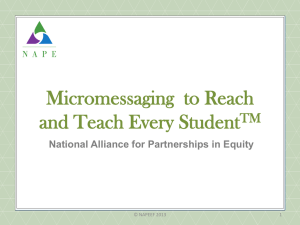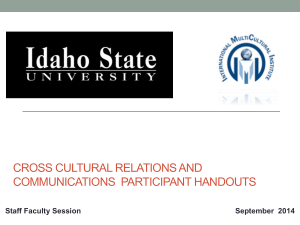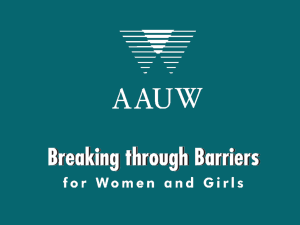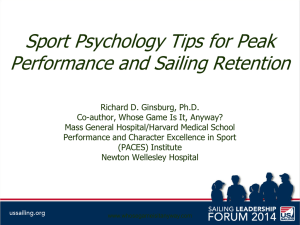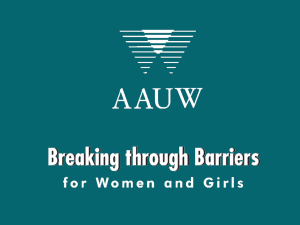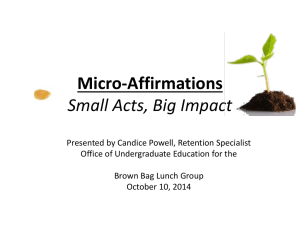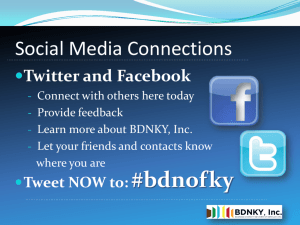Micromessages - MnSCU CTE - Career Technical Education
advertisement
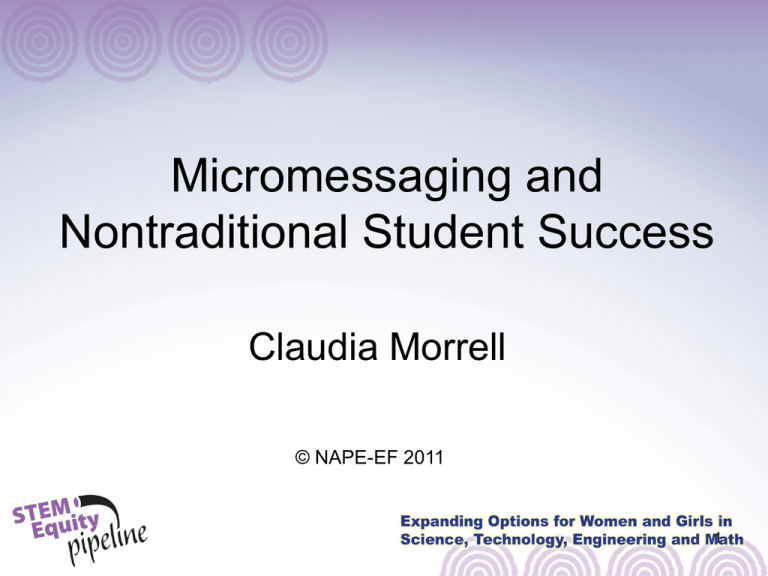
Micromessaging and Nontraditional Student Success Claudia Morrell © NAPE-EF 2011 1 What are examples of Inequitable Access? (Check all that apply) Compared with low-poverty U.S. campuses, highpoverty U.S. campuses have: More teachers educators in areas outside their certification subjects More serious educator turnover problems More educator vacancies Larger numbers of substitute part-time educators More limited access to computers and the Internet Inadequate facilities (such as science labs) More dirty or inoperative bathrooms Lower teacher salaries Presentation Goal To create knowledge among participants of the complexity of issues of equity in our culture and their impact on educators ability to increase the recruitment, academic performance, and program completion of a greater number of students in non-traditional programs. 3 Objectives After completing this presentation, you will be able to demonstrate awareness of: • the National Alliance for Partnerships in Equity and its continued focus on equitable access • micromessages, micro-inequities, and micro-affirmations and the promising practices in Texas that led to the program development • apply a simple scientific process to evaluate your own teaching practices and that can be used to apply and assess the impact of increasing micro-affirmations in the classroom 4 National Alliance For Partnerships in Equity 1990 NAPE founded; by 2011 scaled to 40 member states. 2002 NAPE Education Foundation launched. Mission: Provide equity and diversity solutions for educators to help every student fulfill his or her potential through access to the entire career spectrum. 2007 -2012 • $2.5 M from NSF for STEM Equity Pipeline Project in 12 states. – Involved over 1200 organizations – Conducted research-based training with over 2000 educators, and – Trained school-based teams in 300 schools – Impact is powerful yet isolated – sustainability is unclear due to lack of longitudinal investment and silos NAPE’s Lines of Business National Alliance for Partnerships in Equity Professional Development: STEM Equity Pipeline Provide tools and curricula for educators through conferences, presentations, webinars, and formal training Research and Evaluation Technical Support Public Policy and Advocacy Develop reports. Identify researchbased promising practices. Provide input to others’ research. Develop tools and resources for education agencies. Provide consulting services. Offer expertise on issues pertaining to access, equity, and diversity. Work with federal agencies. Educate legislators on career equity and diversity issues. Develop policy briefs. Alert membership to legislative or policy issues. Professional Development for Educators: STEM (including CTE) Access, Equity, Diversity STEM Equity PipelineTM Program Improvement Process for Equity in STEM Institutional program that improves enrollment, retention & completion of girls & underrepresented populations in STEM courses STEM Equity Teacher Training STEM Equity Counselor Training Tools & Resources Training teachers to use pedagogy that improves enrollment, retention & completion of girls & underrepresented populations in STEM courses Coaching counselors to encourage girls and underrepresented populations in STEM careers Tools to support teachers’ & counselors’ learning and assist their students, e.g., camps, partner orgs, books Percentage of Employed STEM Professionals Who Are Women, Selected Professions 60 Percentage of Women 50 40 30 20 10 0 Biological scientists Environmental scientists Computer programmers and geoscientists Chemical engineers Electrical and electronics engineers Source: U.S. Department of Labor, Bureau of Labor Statistics, 2009, Women in the labor force: A databook (Report 1018) (Washington, DC), Table 11. 8 Women are less likely than men are to declare a STEM major in college. Intent of First-Year College Students to Major in Science and Engineering Fields, by Gender, 2006 35 Physical sciences Mathematics/ statistics 30 Engineering Computer sciences Percentage 25 Biological/ agricultural sciences 20 15 10 5 0 Female Male Source: Commission on Professionals in Science and Technology. Data derived from Cooperative Institutional Research Program, Higher Education Research Institute, Graduate School of Education and Information Studies, University of California, Los Angeles, The American Freshman: National Norms for Fall 1990 through Fall 2006, www.gseis.ucla.edu/heri/heri.htm. 9 STEM Equity Pipeline Program Improvement Process For Equity TM Share Explore Phase One - Orientation Phase Two – Data and Root Cause Analysis Phase Three – Implementation and Evaluation Assess Act Assess Organize Assess Discover Assess Select NAPE-EF 2011© NAPE-EF 2011 As we select the strategy (ies) as interventions remember to… 1. Define the problem 2. Identify a process for the validation of your assumptions of the causes. i.e. collect data and ask why? 3. Select a strategy 4. Implement 5. Assess/measure impact 11 We want strategies that: • Are based on solid data collection and analysis • Lead to an equitable classroom environment • Consider and integrate research-based social and cultural issues • Counteract micro-inequities by building micro-affirmations • Be based on observations, reflection, and data 12 Formation of the Micromessaging Program High Tech High Heels Program Blueprint • Dallas-based program founded by the Women of TI (Texas Instruments) through the Women of TI Fund • One year project to build the program involving a wide diversity of expertise at multiple levels Micromessaging Program Delivery • NSF-funded in Maryland • Program includes multiple partners 13 High Tech High Heels Teacher Professional Development • Since implementation in the first district in 2003, Advanced Placement (AP) Physics test pass rates have improved for both girls and boys: — 4x tests passed by girls — 4x tests passed by African Americans — 6x tests passed by Hispanics • After Equity Training in the second district, the number of AP tests passed by girls more than doubled. 70.00% 60.00% 50.00% 40.00% Girls Boys 30.00% 20.00% 10.00% 0.00% 2002-03 2009-10 15 Assumption #1 Every educator is in the classroom because she or he cares for her or his students and wants each and every one to be successful. 16 Assumption #2 When individuals make remarks that offend someone based on their race, gender, class, ethnicity, ability, etc., they do it unintentionally. This is called innocent ignorance. Addressing this requires openness, education, and communication, not criticism or judgment. 17 Assumption #3 Every student deserves access to an inclusive, equitable educational opportunity, regardless of gender, race, class, religion, (dis)ability, sexual orientation, and so on. 18 Unconscious Bias Culture Behavior Bias Self Efficacy Micromessages Accumulation of (Dis)Advantage Micro-Messaging MICRO-MESSAGES Small, subtle, semi-conscious messages we send and receive when we interact with others MICRO-INEQUITIES Negative micro-messages we send other people that cause them to feel devalued, slighted, discouraged or excluded MICRO-AFFIRMATIONS Positive micro-messages that cause people to feel valued, included, or encouraged 20 Tech Alert October 27, 2011 Dear Members and Readers, Please accept our sincere apologies for the headline in today's Tech Alert: "With the Arduino, Now Even Your Mom Can Program." The actual title of the article is "The Making of Arduino." IEEE Spectrum Why Think About MicroMessaging? Intent Teacher Micro-messaging Engagement with students in the STEM classroom Impact Student Performance Small and seemingly insignificant behaviors may result in unfavorable learning outcomes Impact is More Important Than Intent! 22 Key Micromessaging Elements • • • • Verbal (What is said) Para-Verbal (How it’s said) Non-Verbal (Body Language) Contextual (Who or what else is present; culture, artifacts, etc.) • Omission (what is not said or not done) • Praise and Criticism (feedback messages) 23 © NAPE-EF 2011 E Examining the Small Consider for a moment a specific incident when you were being… • unintentionally discouraged or hurt by something SMALL someone said or did. • deeply valued by your colleague or family member in a SMALL yet powerful way. - How did you know? What did that person do to communicate your value? © NAPE-EF 2011 24 Guess the Cues Which is an example of a verbal cue? • Chronically mispronouncing select student names. • Don’t tolerate girls calling out answers but tolerates that behavior from boys • Discipline boys more than girls for similar behavior • Consistent use of generic “he” or “man” to represent both men and women • Avoiding eye contact with female student; only looking at male students • Only use males as examples of scientists Guess the Cues Which is an example of an omission cue? • Chronically mispronouncing select student names. • Don’t tolerate girls calling out answers but tolerates that behavior from boys • Discipline boys more than girls for similar behavior • Consistent use of generic “he” or “man” to represent both men and women • Avoiding eye contact with female student; only looking at male students • Only use males as examples of scientists Guess the Cues Which is an example of a nonverbal cue? • Chronically mispronouncing select student names. • Don’t tolerate girls calling out answers but tolerates that behavior from boys • Discipline boys more than girls for similar behavior • Consistent use of generic “he” or “man” to represent both men and women • Avoiding eye contact with female student; only looking at male students • Only use males as examples of scientists Negative Bias = Micro-Inequities • • • • • Often Unconscious Usually Unintentional Subtle Pervasive Powerful © NAPE-EF 2011 28 Positive Bias = Micro-Affirmations Micro-messages we send that validate and recognize other people in positive and supportive ways. © NAPE-EF 2011 29 Micro-Affirmations for Learning Which of the following are examples of sending Micro- affirmations that you might use? • Interrupt micro-inequities you observe • Plant micro-affirmations • Assign females and males to activities by skill not gender • Affirm students for their effort, not by perceived attributes • Allow “wait time” before calling on students • Implement a system for calling on students, such as using shuffled index cards containing students’ names 30 Impact of Micro-Affirmations on Girls in STEM • Increased their willingness to take risks • Enhanced creativity and innovation • Increased levels of engagement in complex tasks and open-ended thinking • Improved caring about learning • Increased interest in STEM and development of girls’ STEM-identity 31 © NAPE-EF 2011 The Role of Parents in Micromessaging, Equity and Access So, young women might have equal access to non-traditional careers, but they certainly do not have equitable access. An equity approach takes bigger social and educational conditions into account—such as the influence of parents, media, and culture in general. Educating parents so that they can encourage students through affirmations to consider non-traditional careers can be an important ally! The educator as classroom scientist 33 Let’s Review: STEP 1: Define the problem (Set up your hypothesis!) • Recruitment • Retention • Pass rate • Grade performance • Classroom Climate 34 Let’s Review: STEP 2: Identify a process for the validation of your assumptions of the causes (Collect data and ask why?) 35 Suggested Strategies for Gathering Data • Peer classroom observation • Gender reverse review of physical space • Observe your students with a checklist for micromessages • Review curriculum and lesson plans for contextual clues • Learn more ! © NAPE-EF 2011 36 Let’s Review: STEP 3: Select a strategy – (define independent and dependent variables) (See www.napequity.org for researchbased root cause document) 37 Let’s Review: STEP 4: • Implement STEP 5: • Assess/measure impact (Share) Revise STEP 1: • Define the problem (Revise your hypothesis!) 38 Did You Learn About…? After completing this presentation, do you have more awareness of: (Mark √ for Yes or X for No) • the National Alliance for Partnerships in Equity and its continued focus on equitable access • micromessages, micro-inequities, and micro-affirmations and the promising practices in Texas that led to the program development • applying a simple scientific process to evaluate your own teaching practices • applying this process to assessing the impact of increasing micro-affirmations in the classroom 39 Questions? • What information, training or resources would you like to more about? “Diversity Trumps Ability Every Time.” Page (2007). The Difference: How the power of diversity creates better groups, firms, schools, and societies. For more information About NAPE and the STEM Equity Pipeline www.napequity.org www.stemequitypipeline.org Claudia Morrell cmorrell@napequity.org For further professional development Debra Hsu debra.hsu@so.mnscu.edu Eva Scates-Winston eva.scates-winston@so.mnscu.edu Al Hauge al.hauge@state.mn.us
